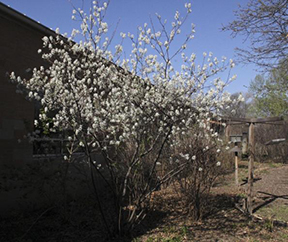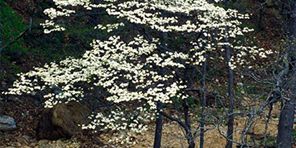JEFFERSON CITY, Mo. – Spring is an opportune time to plant a new tree, but the Missouri Department of Conservation (MDC) encourages the public to steer clear of one species – the Bradford or Callery pear.
The Callery pear, also known as the Bradford pear, Cleveland Select, Autumn Blaze, or Aristocrat, is a non-native and highly invasive species that multiplies quickly and crowds out Missouri native plants

The invasive Bradford or Callery pear tree was introduced as an ornamental tree in the 1960s, but has since become an environmental nuisance. MDC encourages the public to plant native when selecting trees this spring.
“The Callery pear became a popular ornamental landscape tree in the 1960s because it was inexpensive, it grew fast, and provided those eye-catching blooms in the spring,” explained MDC Forestry Program Supervisor Russell Hinnah. “But that’s where its benefits end. Different varieties of the tree were planted close to each other, which resulted in cross pollination and they took over natural areas.”
The Callery pear is infamous for its stinky smell, but also has a poor branch structure. The trees don’t fare well in storms, often losing limbs or splitting apart.

Native serviceberry (pictured) is a great alternative to the Callery pear. It produces showy white blooms and has small red fruits that attract wildlife.
MDC encourages homeowners and landscapers to grow native when picking a tree to plant.
“The best option is to select species native to Missouri, and there are many great trees to substitute,” said Hinnah. “Serviceberry trees produce similar showy white blooms in the spring and have small red fruits that attract wildlife.”
Other great alternatives include American plum, hawthorn, eastern redbud, and Missouri’s state tree, the flowering dogwood. Hawthorns provide bountiful fruit and attractive fall color. Dogwoods thrive in shady areas, but can be difficult to grow.

Missouri’s state tree, the flowering dogwood (pictured), is another native tree that produces beautiful blooms and provide ecological benefits.
CALLERY PEAR BUY-BACK EVENTS
Missourians with Callery pear trees on their property have the option to cut down their trees and receive a free, non-invasive tree at several “buy-back” events around the state April 26. The events are sponsored by Forest ReLeaf of Missouri, Missouri Invasive Plant Council, and MDC.
Participants must register by visiting moinvasives.org. They will also need to submit a photo of themselves next to their cut-down Callery pear tree in order to receive one replacement tree.
Callery pear Buy-Back events are planned for April 26 from 3 p.m. – 6 p.m. in the following locations:
- MDC Central Regional Office in Columbia
- MDC Cape Girardeau Nature Center
- MDC Shoal Creek Conservation Education Center in Joplin
- Lakeside Nature Center in Kansas City
- CommuniTree Gardens in St. Louis
- MDC Southwest Regional Office in Springfield
For more information about the buy-back events and how to participate, visit moinvasives.org.
To learn more about native trees for landscaping, planting tips, backyard tree care, and more, visit https://mdc.mo.gov/trees-plants/tree-care.

